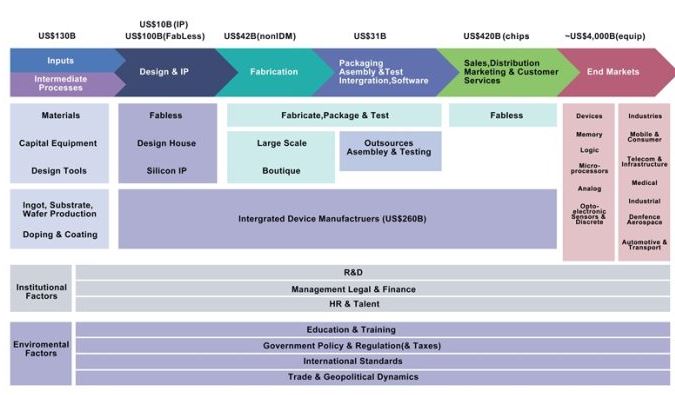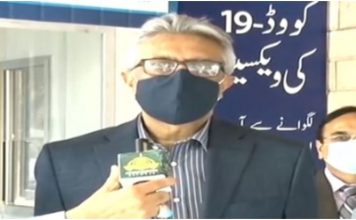BEIJING: Mar 01, 2022 (TNS): China and Pakistan have great potential in semiconductor cooperation and the two countries could work on designing chips for consumer goods like cellphones, mobile infrastructure networks, data centres and, IoT devices.
“Pakistani semiconductor industry is at a very beginning stage. We have some capabilities of [chip] design. We have few companies that design their own chips or work in an outsourcing fashion for design centres…But overall, Pakistan is starting from ground zero,” revealed Dr Naveed Sherwani, Chairman of the Global Semiconductor Group, in an interview with China Economic Net (CEN).
Terming semiconductors as an existential industry for Pakistan, he said that in recent years, a growing number of Asian players have made forays into the lucrative sector. However, Pakistan is still lagging in this sector.
According to Dr Sherwani, the semiconductors industry is an economic and sovereign lifeline. “It is like growing food with your water. You’re not going to ask some other nations to make food for you. If the next thing that we eat is information and the next oil is data, then semiconductor is the thing that you use to consume data and move the system,” the chip expert said.
In a February webinar on the Pakistani semiconductor industry, he predicted that the industry could bring up to US$4 billion in forex to Pakistan each year if the country can get 100,000 semiconductor talent involved in the next 5 to 6 years.
On the role of Pakistan in the semiconductor arena, he said that to catch up and exploit the full potential of the semiconductor industry, Pakistan proposed the long-awaited Pakistan National Semiconductor Plan (PNSP) in January.
Devised by a panel of 16 industry veterans and scholars headed by Dr Naveed Sherwani, the historic semiconductor roadmap, among others, positions the country as a potential hub for chip design and light fabrication.
The semiconductor chain involves three major areas: design, fabrication, and assembly, testing, and packaging (ATP). A former chip engineer at Intel for ten years and the major expert behind the PNSP, Dr Sherwani exclaimed that Pakistan should start with chip design before venturing into ATP services.
“Developing countries are not ready to set up a fab [or fabrication plant] because a fab is not just one factory but it is a host of 50 to 60 factories,” Dr Sherwani explained, “It is a matter of a very big, complex capital-intensive ecosystem.”
Chip design and ATP services, on the other hand, are a more viable option as such divisions are labour-intensive and Pakistan has a relatively adequate stock of talent in place, amid the global talent shortage in the industry.
In the US alone, around 70,000 to 90,000 workers or more will have to be added by 2025 from 2020 levels to meet the most critical workforce needs, according to a report by Eightfold.ai, a talent-management company.
However, the scenario is even worse in China partly due to the exponential growth in its semiconductor industry. As per Qcc.com, a Chinese web portal dedicated to authoritative information on enterprises, China had a total of more than 66,5000 chip-related enterprises by 2020, and nearly 15,000 Chinese firms registered as semiconductor enterprises in 2020 alone. For this reason, in the integrated circuit (IC) sector alone, there will be a shortage of nearly 230,000 semiconductor professionals in China by 2023, predicted the China Integrated Circuit Industry Talent Development Report 2020-2021.
Having established 18 chip-related firms around the globe including five enterprises in China, Dr Sherwani explicated,China needs a lot of chip designers and trained workers.
The number could be anywhere between 300,000 to 500,000. China does not have those people today, so they will have to be either produced in China or they will have to come from somewhere else.
The entrepreneur sees great potential for China-Pakistan cooperation in this regard. “I think Pakistan can help China by providing, let’s say, 100,000 [semiconductor] people. Those people can either move to China or they can operate in Pakistan,” Dr Sherwani said.
In an early February interview with CEN during his visit to China with Prime Minister Imran Khan, Federal Minister for Information and Broadcasting Chaudhry Fawad said that Pakistan hopes to set up a semiconductor zone with China’s help.
To this end, Pakistan will provide favourable, enabling policies for Chinese tech companies as advised by the PNSP, according to Dr Sherwani.
“Chinese companies can come inside the zone and leave the zone with no tax or customs. Make it very simple.” In such technology zones, the two countries can work on needy chips for consumer goods such as cellphones, mobile infrastructure networks, data centres and, IoT devices, said Dr Sherwani.
“We need a lot of people to mature it [such breakthrough technologies] and grow it and do all the experimentation,” Dr Sherwani claimed, “I think that [setting up a technology zone] would be beneficial for both countries. The initial semiconductor development in Pakistan can happen inside the zone. And hopefully, we may venture out of the zone.”
It may be mentioned here that the semiconductor chain has penetrated into nearly every aspect of modern life and the semiconductor industry has blossomed into a multi-trillion-dollar industry. According to SEMI 2020 report, the global semiconductor market for just the chips themselves is currently valued at around US$425 billion per year and by some estimates is forecast to hit US$1 trillion by 2030.















